Dutch-born actor Roland Varno (1908-1996) is best known for his role as one of the schoolboys in the German classic Der blaue Engel/The Blue Angel (1930). Varno appeared in several German and Dutch films of the early 1930s and he also worked in Hollywood as a character actor, mainly in B-pictures.

Dutch postcard, no. 1.
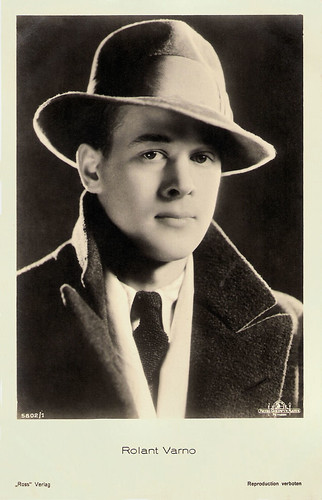
German postcard by Ross Verlag, no. 5802/1, 1930-1931. Photo: Metro-Goldwyn-Mayer.
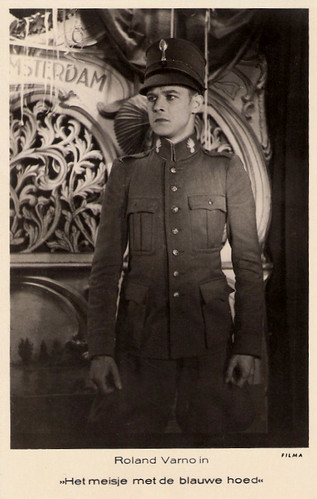
Dutch postcard by M.B.& Z. (M. Bonnist & Zonen, Amsterdam). Photo: Filma. Publicity still for Het meisje met de blauwe hoed/The Girl With the Blue Hat (Rudolf Meinert, 1934). Collectie: Geoffrey Donaldson Institute.

Dutch postcard by M.B.& Z. (M. Bonnist & Zonen, Amsterdam), no. 10. Photo: Loet C. Barnstijn Film. Still for Malle gevallen/Silly Situations (Jaap Speyer, 1934) with Enny Meunier.
Roland (sometimes Rolant) Varno was born as Jacob Frederik Vuerhard in Utrecht, The Netherlands, in 1908. His sister, Anneke, was for many years the Dear Abby of Holland. Roland spent his younger years on the island of Java, but he moved back to Holland as a teenager.
At the end of the 1920s he went to Berlin to work in the film industry and soon he won leading parts in the films Zwischen vierzehn und siebzehn - Sexualnot der Jugend/Between 14 and 16 - Sexual Needs of Youth (E.W. Emo, 1929) and Jugendtragödie/Youth Tragedy (Alfred Trotz, 1929).
His next role was in the German classic Der Blaue Engel/The Blue Angel (Josef van Sternberg, 1930), which made Marlene Dietrich an international star. He played one of the pupils of Emil Jannings who secretly frequent Dietrich’s sleazy shows in The Blue Angel cabaret.
Varno had another supporting role in the popular Heinz Rühmann comedy Der Mann, der seinen Mörder sucht/Looking for His Murderer (Robert Siodmak, 1931).
In 1930, he moved to the U.S. to shoot All Quiet on the Western Front (Lewis Mileastone, 1930). His ship was stalled in the Atlantic so the role went instead to Lew Ayers, who became both a major star and Roland's best friend.

Dutch autograph card, 1930. Caption: In memory to my visit to the Trianon Theatre, The Hague, December 1930.

German postcard by Ross Verlag, no. 186/4, 1931-1933. Photo: Metro-Goldwyn-Mayer. Publicity still for As You Desire me (George Fitzmaurice, 1932) with Greta Garbo.
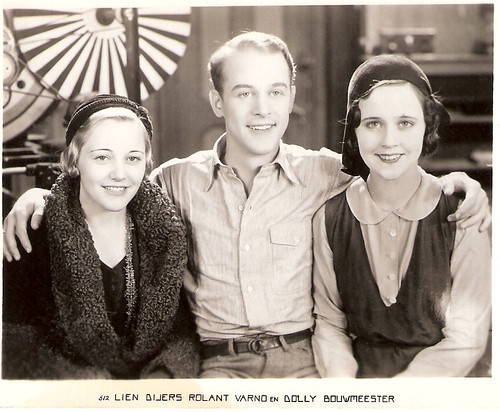
Dutch postcard for the Dutch film De Sensatie der toekomst (Dimitri Buchowetzki, Jack Salvatori, 1931) with Lien Deyers and Dolly Bouwmeester. Deyers was not in the film, but visited the Paramount studios during the shooting.
In the Paramount studio in France, he played in De sensatie der toekomst (Victor Buchowetzki, Jack Salvatori, 1931), a Dutch version of the French production Magie Moderne/Modern Magic (Dimitri Buchowetzki, 1931). He starred with Dolly Bouwmeester in this SF detective film about the new phenomenon television - the 'sensation of the future'.
After this early Dutch sound film, he returned to Hollywood but there he found only small roles in films like Arsène Lupin (Jack Conway, 1932) and the Greta Garbo vehicle As You Desire Me (George Fitzmaurice, 1932).
Varno returned to the Netherlands to star as a girl-shy soldier in the musical comedy Het meisje met den blauwen hoed/The Girl with the Blue Hat (Rudolph Meinert, 1934), co-starring with Truus van Aalten and Lou Bandy.
Then he starred in another Dutch comedy Malle gevallen/Silly Situations (Jaap Speyer, 1934) with Enny Meunier, Louis Borel and Johan Kaart.
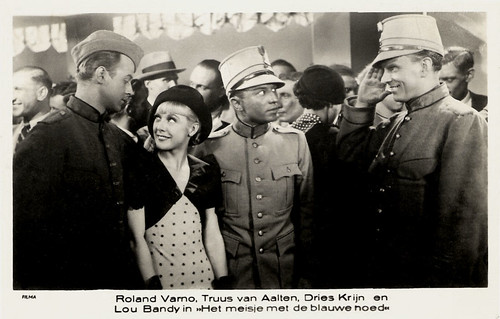
Dutch postcard by M. B.& Z. (M. Bonnist & Zonen, Amsterdam). Photo: Filma. Still for Het meisje met den blauwen hoed/The Girl with the Blue Hat (1934) with Truus van Aalten, Dries Krijn and Lou Bandy.
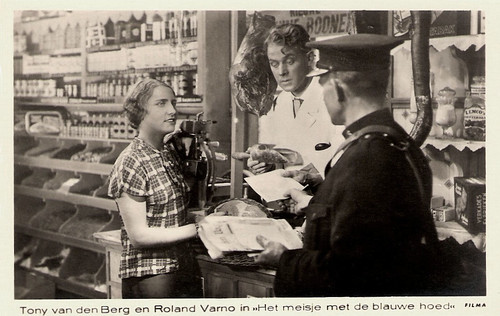
Dutch postcard by M. B.& Z. (M. Bonnist & Zonen, Amsterdam). Photo: Filma.Still for Het meisje met den blauwen hoed/The Girl with the Blue Hat (1934) with Tony van den Berg.

Dutch postcard by M. B.& Z. (M. Bonnist & Zonen, Amsterdam). Photo: Filma. Still for Het meisje met den blauwen hoed/The Girl with the Blue Hat (1934) with Truus van Aalten.
Roland Varno returned to Hollywood but for years he only found bit roles, often uncredited.
In 1939 he played a spy in a short film by Fred Zinnemann, While America Sleeps (1939). More supporting roles followed in the Nelson Eddy musical Balalaika (Reinhold Schünzel, 1939), the war drama Mystery Sea Raider (Edward Dmytryk, 1940), another war drama Underground (Vincent Sherman, 1941) and the Western Valley of Hunted Men (John English, 1941).
Varno had his first major screen credit in Hollywood in The Return of the Vampire (Lew Landers, 1944), starring Bela Lugosi and Nina Foch.
Varno was fluent in several languages and during WW II, he was placed in the Office of Strategic Services and appeared in several propaganda movies, including The Unwritten Code (Herman Rotsten, 1944). In this offbeat, better-than-average war drama Ann Savage and Tom Neal were top-billed, but Varno was the central character. He played a Nazi spy who sneaks into the U.S., hoping to release hundreds of German prisoners.
Other career highlights were the wartime drama Hostages (Frank Tuttle, 1943) with Luise Rainer and William Bendix and the Film Noir My Name Is Julia Ross (Joseph H. Lewis, 1945) starring Nina Foch.
His linguistic versatility came in handy after the war and made him a popular performer in radio programs across the country. In the 1950s he was also often seen as a guest star in TV series.
He made his last movie appearance in Istanbul (Joseph Pevney, 1957) starring Errol Flynn and Cornell Borchers.
Several years into his retirement, Varno's language skills again came in handy on the set of the TV miniseries War and Remembrance (1988).
Roland Varno died in 1996 in Lancaster, California. His son is the Emmy nominated sound editor Martin Varno. His daughter is Jill Taggart.
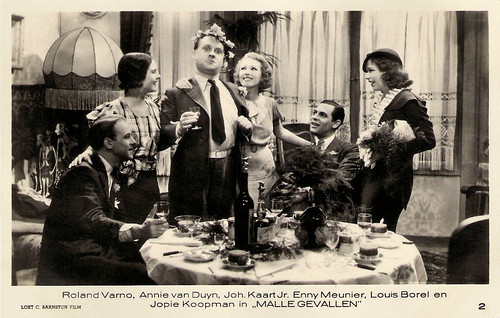
Dutch postcard by Loet C. Barnstijn Film, no. 2. Photo: still for Malle Gevallen/Silly Situations (Jaap Speyer, 1934). Collectie: Geoffrey Donaldson Institute.
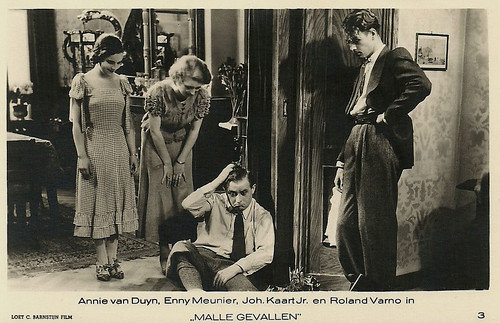
Dutch postcard by M.B. & Z, no. 3. Photo: Loet C. Barnstijn Film. Still for Malle Gevallen/Silly Situations (Jaap Speyer, 1934).
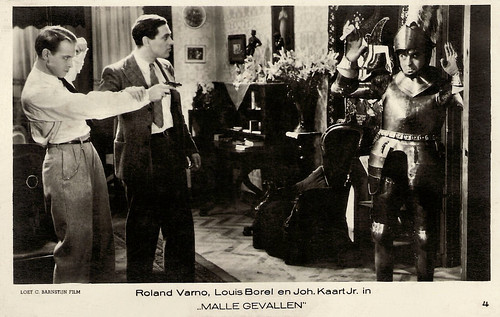
Dutch postcard by M.B. & Z, no. 4. Photo: Loet C. Barnstijn Film. Still for Malle Gevallen/Silly Situations (Jaap Speyer, 1934).

Dutch postcard by M. B.& Z. (M. Bonnist & Zonen, Amsterdam), no. 6. Photo: Loet C. Barnstijn Film. Still for Malle Gevallen/Silly Situations (Jaap Speyer, 1934).
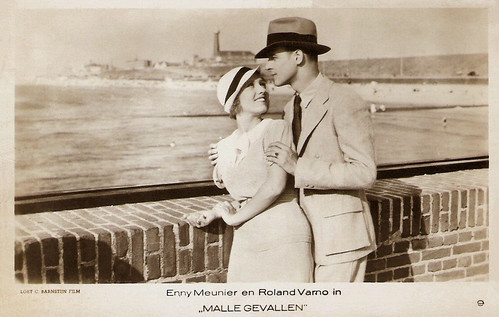
Dutch postcard by M. B.& Z. (M. Bonnist & Zonen, Amsterdam), no. 9. Photo: Loet C. Barnstijn Film. Still for Malle Gevallen/Silly Situations (Jaap Speyer, 1934).

Dutch postcard by Loet C. Barnstijn Film, no. 11. Photo: still for Malle Gevallen/Silly Situations (Jaap Speyer, 1934). Collectie: Geoffrey Donaldson Institute.
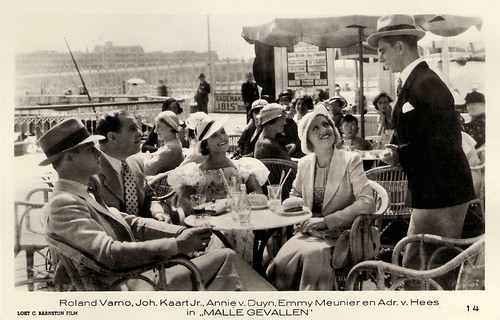
Dutch postcard by Loet C. Barnstijn Film, no. 14. Photo: still for Malle Gevallen/Silly Situations (Jaap Speyer, 1934). Collectie: Geoffrey Donaldson Institute.
Sources: Sandra Brennan (AllMovie), Wikipedia and IMDb.

Dutch postcard, no. 1.

German postcard by Ross Verlag, no. 5802/1, 1930-1931. Photo: Metro-Goldwyn-Mayer.

Dutch postcard by M.B.& Z. (M. Bonnist & Zonen, Amsterdam). Photo: Filma. Publicity still for Het meisje met de blauwe hoed/The Girl With the Blue Hat (Rudolf Meinert, 1934). Collectie: Geoffrey Donaldson Institute.

Dutch postcard by M.B.& Z. (M. Bonnist & Zonen, Amsterdam), no. 10. Photo: Loet C. Barnstijn Film. Still for Malle gevallen/Silly Situations (Jaap Speyer, 1934) with Enny Meunier.
Sleazy Shows
Roland (sometimes Rolant) Varno was born as Jacob Frederik Vuerhard in Utrecht, The Netherlands, in 1908. His sister, Anneke, was for many years the Dear Abby of Holland. Roland spent his younger years on the island of Java, but he moved back to Holland as a teenager.
At the end of the 1920s he went to Berlin to work in the film industry and soon he won leading parts in the films Zwischen vierzehn und siebzehn - Sexualnot der Jugend/Between 14 and 16 - Sexual Needs of Youth (E.W. Emo, 1929) and Jugendtragödie/Youth Tragedy (Alfred Trotz, 1929).
His next role was in the German classic Der Blaue Engel/The Blue Angel (Josef van Sternberg, 1930), which made Marlene Dietrich an international star. He played one of the pupils of Emil Jannings who secretly frequent Dietrich’s sleazy shows in The Blue Angel cabaret.
Varno had another supporting role in the popular Heinz Rühmann comedy Der Mann, der seinen Mörder sucht/Looking for His Murderer (Robert Siodmak, 1931).
In 1930, he moved to the U.S. to shoot All Quiet on the Western Front (Lewis Mileastone, 1930). His ship was stalled in the Atlantic so the role went instead to Lew Ayers, who became both a major star and Roland's best friend.

Dutch autograph card, 1930. Caption: In memory to my visit to the Trianon Theatre, The Hague, December 1930.

German postcard by Ross Verlag, no. 186/4, 1931-1933. Photo: Metro-Goldwyn-Mayer. Publicity still for As You Desire me (George Fitzmaurice, 1932) with Greta Garbo.

Dutch postcard for the Dutch film De Sensatie der toekomst (Dimitri Buchowetzki, Jack Salvatori, 1931) with Lien Deyers and Dolly Bouwmeester. Deyers was not in the film, but visited the Paramount studios during the shooting.
The Sensation of the Future
In the Paramount studio in France, he played in De sensatie der toekomst (Victor Buchowetzki, Jack Salvatori, 1931), a Dutch version of the French production Magie Moderne/Modern Magic (Dimitri Buchowetzki, 1931). He starred with Dolly Bouwmeester in this SF detective film about the new phenomenon television - the 'sensation of the future'.
After this early Dutch sound film, he returned to Hollywood but there he found only small roles in films like Arsène Lupin (Jack Conway, 1932) and the Greta Garbo vehicle As You Desire Me (George Fitzmaurice, 1932).
Varno returned to the Netherlands to star as a girl-shy soldier in the musical comedy Het meisje met den blauwen hoed/The Girl with the Blue Hat (Rudolph Meinert, 1934), co-starring with Truus van Aalten and Lou Bandy.
Then he starred in another Dutch comedy Malle gevallen/Silly Situations (Jaap Speyer, 1934) with Enny Meunier, Louis Borel and Johan Kaart.

Dutch postcard by M. B.& Z. (M. Bonnist & Zonen, Amsterdam). Photo: Filma. Still for Het meisje met den blauwen hoed/The Girl with the Blue Hat (1934) with Truus van Aalten, Dries Krijn and Lou Bandy.

Dutch postcard by M. B.& Z. (M. Bonnist & Zonen, Amsterdam). Photo: Filma.Still for Het meisje met den blauwen hoed/The Girl with the Blue Hat (1934) with Tony van den Berg.

Dutch postcard by M. B.& Z. (M. Bonnist & Zonen, Amsterdam). Photo: Filma. Still for Het meisje met den blauwen hoed/The Girl with the Blue Hat (1934) with Truus van Aalten.
Bit roles
Roland Varno returned to Hollywood but for years he only found bit roles, often uncredited.
In 1939 he played a spy in a short film by Fred Zinnemann, While America Sleeps (1939). More supporting roles followed in the Nelson Eddy musical Balalaika (Reinhold Schünzel, 1939), the war drama Mystery Sea Raider (Edward Dmytryk, 1940), another war drama Underground (Vincent Sherman, 1941) and the Western Valley of Hunted Men (John English, 1941).
Varno had his first major screen credit in Hollywood in The Return of the Vampire (Lew Landers, 1944), starring Bela Lugosi and Nina Foch.
Varno was fluent in several languages and during WW II, he was placed in the Office of Strategic Services and appeared in several propaganda movies, including The Unwritten Code (Herman Rotsten, 1944). In this offbeat, better-than-average war drama Ann Savage and Tom Neal were top-billed, but Varno was the central character. He played a Nazi spy who sneaks into the U.S., hoping to release hundreds of German prisoners.
Other career highlights were the wartime drama Hostages (Frank Tuttle, 1943) with Luise Rainer and William Bendix and the Film Noir My Name Is Julia Ross (Joseph H. Lewis, 1945) starring Nina Foch.
His linguistic versatility came in handy after the war and made him a popular performer in radio programs across the country. In the 1950s he was also often seen as a guest star in TV series.
He made his last movie appearance in Istanbul (Joseph Pevney, 1957) starring Errol Flynn and Cornell Borchers.
Several years into his retirement, Varno's language skills again came in handy on the set of the TV miniseries War and Remembrance (1988).
Roland Varno died in 1996 in Lancaster, California. His son is the Emmy nominated sound editor Martin Varno. His daughter is Jill Taggart.

Dutch postcard by Loet C. Barnstijn Film, no. 2. Photo: still for Malle Gevallen/Silly Situations (Jaap Speyer, 1934). Collectie: Geoffrey Donaldson Institute.

Dutch postcard by M.B. & Z, no. 3. Photo: Loet C. Barnstijn Film. Still for Malle Gevallen/Silly Situations (Jaap Speyer, 1934).

Dutch postcard by M.B. & Z, no. 4. Photo: Loet C. Barnstijn Film. Still for Malle Gevallen/Silly Situations (Jaap Speyer, 1934).

Dutch postcard by M. B.& Z. (M. Bonnist & Zonen, Amsterdam), no. 6. Photo: Loet C. Barnstijn Film. Still for Malle Gevallen/Silly Situations (Jaap Speyer, 1934).

Dutch postcard by M. B.& Z. (M. Bonnist & Zonen, Amsterdam), no. 9. Photo: Loet C. Barnstijn Film. Still for Malle Gevallen/Silly Situations (Jaap Speyer, 1934).

Dutch postcard by Loet C. Barnstijn Film, no. 11. Photo: still for Malle Gevallen/Silly Situations (Jaap Speyer, 1934). Collectie: Geoffrey Donaldson Institute.

Dutch postcard by Loet C. Barnstijn Film, no. 14. Photo: still for Malle Gevallen/Silly Situations (Jaap Speyer, 1934). Collectie: Geoffrey Donaldson Institute.
Sources: Sandra Brennan (AllMovie), Wikipedia and IMDb.
3 comments:
Unforgettable. Very much.
Thanks,
O Falcão Maltês
Dear Sir, Madam,
what an interesting blog!
one remark about "Television/De Sensatie der toekomst" (1931): Lien Deyers did not star in this film. Miss Deyers, who had a steep career in Germany at that time, merely came to visit the set. The picture was first used for newspaper syndication and later used for a postcard, thus causing the misconception. The film itself is considered lost.
Regards, Michiel
check
https://resolver.kb.nl/resolve?urn=ddd:011116420:mpeg21:p016
the top foto: De jonge Brakensiek en Lien Deyers, die tijdens de opnamen de Paramount-studio's bezócht. (the young Brakensiek and Lien Deyers, who visited the Paramount studios during the shooting.)
Hé Michiel,
Zie nu pas je commentaar. Bedankt!
Logisch eigenlijk, gezien de jas van Lien Deyers. Ik heb het overal aangepast.
Groet,
Paul
Post a Comment